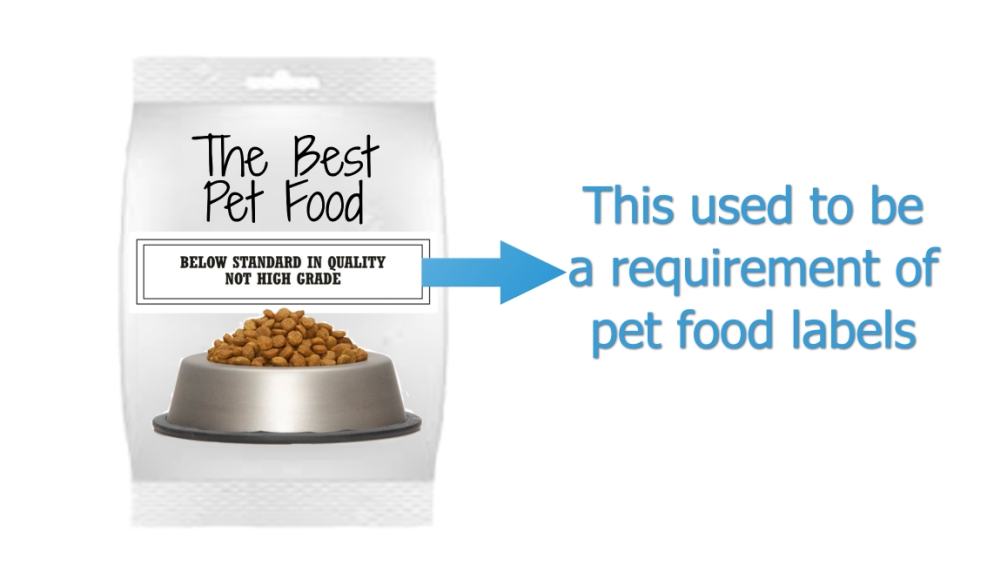In 1995 there was a section of federal law regarding pet food and animal food – Code of Federal Regulations, Title 21, Chapter 1, Subchapter E, Part 564 “Definitions and Standards for Animal Food“. The “standard” for animal food in the 1995 law required (bold added) “the food and all articles used as components or ingredients thereof shall not be poisonous or deleterious and shall be clean, sound, and fit for food.“
In 1995 if a pet food that used ingredients that were not “fit for food” Part 564 of these federal laws required a disclosure on the pet food label, to alert the consumer the product was “Not High Grade”. The 1995 laws required the pet food label to include this on the front of the package near the name of the pet food:

Federal law has the exact same requirement for human food; that was in place in 1995 and is still in place today. In the book Food Labeling from the Institute of Medicine, researchers stated the human food application of the law “deters the marketing of products that do not meet the standards.”
As we don’t see human food products with the above “Not High Grade” disclosure on labels, the law certainly does ‘deter’ the sale of lesser quality foods.
But what about pet foods?
In 1995, we can assume this law also deterred pet food manufacturers from using unfit for food ingredients – as it would today IF this law was still a law. But it isn’t a law today for pet food, because the FDA deleted this entire section of law in 1999 (see page 17). FDA did not delete the law for human food, they only deleted the law for pet food.
And this isn’t the only time FDA disagreed with a legal requirement of pet food ingredient quality standard. In 2007 (eight years after FDA deleted the original pet food ingredient standard) – after the deadly melamine recall – Congress wrote new laws requiring FDA to establish ingredient standards in pet food.
Section 1002 (a) of the Food and Drug Administration Amendments Act required FDA to establish “ingredient standards and definitions with respect to pet food” by September 2009. But, FDA never established pet food ingredient standards, they ignored the laws for years. And the laws were ultimately deleted – again – by FDA in 2018 (with assistance from AAFCO and the industry trade association AFIA).
Twice the FDA has taken from us laws that would provide pet owners transparency in pet food.
Tell the FDA you want the required disclosure for substandard ingredient pet foods to be reinstated. Email FDA at AskCVM@fda.hhs.gov. If ingredients are feed grade, the pet food label should disclose that to consumers. Such as the below being required on labels:

FDA has the ability to establish a standard of quality for pet food ingredients (they don’t need a law written by Congress). The Federal Food Drug and Cosmetic Act gives the FDA this authority. Subchapter IV Food, Section 341 states: “Whenever in the judgment of the Secretary such action will promote honesty and fair dealing in the interest of consumers, he shall promulgate regulations fixing and establishing for any food, …a reasonable standard of quality…” Without doubt, the required disclosure of feed grade ingredients is ‘reasonable’ and would ‘promote honesty and fair dealing in the interest of consumers’.
Does the FDA care about pet food consumers and honesty in pet food labels or not? Ask them to care.
Wishing you and your pet(s) the best,
Susan Thixton
Pet Food Safety Advocate
Author Buyer Beware, Co-Author Dinner PAWsible
TruthaboutPetFood.com
Association for Truth in Pet Food

Become a member of our pet food consumer Association. Association for Truth in Pet Food is a stakeholder organization representing the voice of pet food consumers at AAFCO and with FDA. Your membership helps representatives attend meetings and voice consumer concerns with regulatory authorities. Click Here to learn more.
What’s in Your Pet’s Food?
Is your dog or cat eating risk ingredients? Chinese imports? Petsumer Report tells the ‘rest of the story’ on over 5,000 cat foods, dog foods, and pet treats. 30 Day Satisfaction Guarantee. Click Here to preview Petsumer Report. www.PetsumerReport.com
Find Healthy Pet Foods in Your Area Click Here

The 2021 List
Susan’s List of pet foods trusted to give her own pets. Click Here to learn more.



























Biju Naidu
June 7, 2021 at 6:28 am
The FDA (Food and Drug Administration) is a world-recognized agency responsible for supervising food safety, pharmaceutical drugs, dietary supplements, tobacco products, vaccines, medical devices and various other food, drug and cosmetic products. The authorized body ensures and protects public health through a well-organized regulatory-enforcement work. The FDA mandated transparent label on human food products indicate that the food is safe for consumption and contains no harmful ingredients. The FDA approved mark/label helps us to recognize which food products are safe and healthy. A similar label on the pet foods would have also helped pet parents to differentiate between high quality pet foods from the substandard ones. This article rightly points out that the FDA label on pet foods is as equally important as on the human food products. Whether it’s for human or animals, the FDA transparent label is necessary to alert the consumer if the food product is high grade and conforms to the prescribed quality standard.